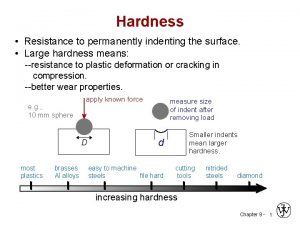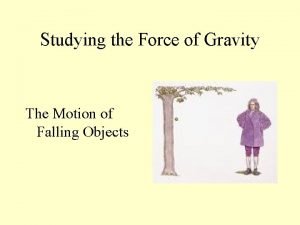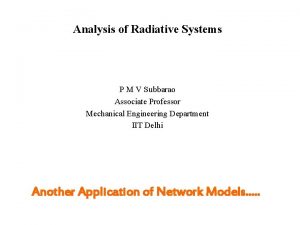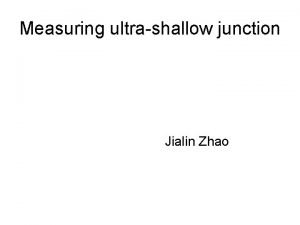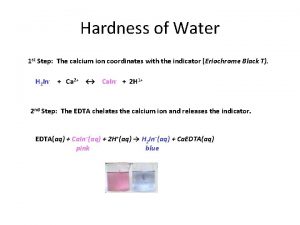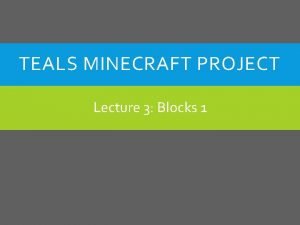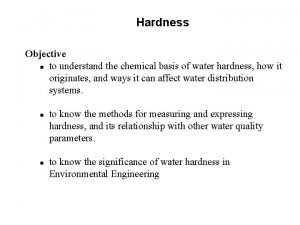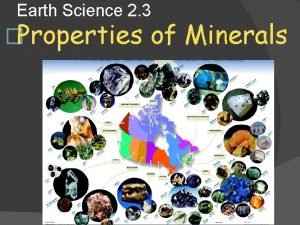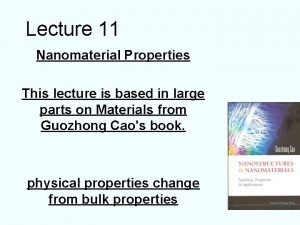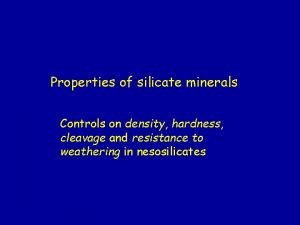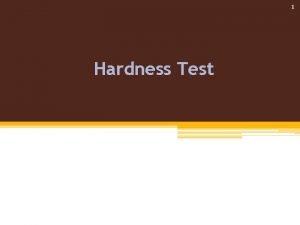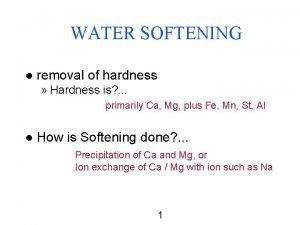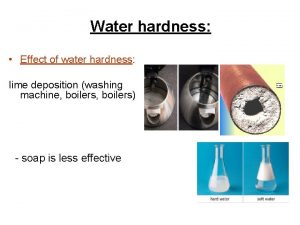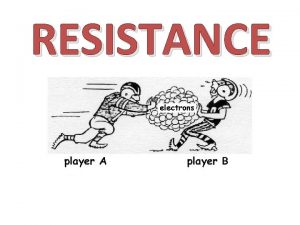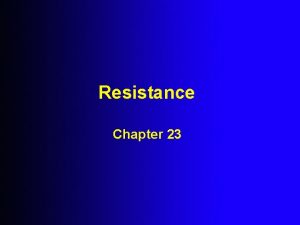Hardness Resistance to permanently indenting the surface Large


























- Slides: 26

Hardness • Resistance to permanently indenting the surface. • Large hardness means: --resistance to plastic deformation or cracking in compression. --better wear properties. e. g. , 10 mm sphere apply known force D most plastics brasses Al alloys measure size of indent after removing load Smaller indents mean larger hardness. d easy to machine steels file hard cutting tools nitrided steels diamond increasing hardness Chapter 9 - 1

Hardness: Measurement • Rockwell – A, B and C scale – No major sample damage – Each scale runs to 130 but only useful in range 20100. – Minor load 10 kg – Major load 60 (A), 100 (B) & 150 (C) kg • A = diamond, B = 1/16 in. ball, C = diamond • Brinell Hardness - HB (Load 3, 000 kg for hard materials or 500 kg for soft materials, dwell time = 30 sec) – TS (psia) = 500 x HB – TS (MPa) = 3. 45 x HB Chapter 9 - 2

Hardness: Measurement • Vickers Hardness - HV – Use square based diamond pyramid as indenter – Received fairly wide acceptance in research – Not widely accepted for routine testing because it is slow, require grater surface preparation – Greater chance for personal error (a) Perfect Indentation (b) pincushion indentation due to sinking in (annealed materials) (c) barreled indentation due to piling up (cold worked materials) Chapter 9 - 3

Hardness: Measurement üPincushion indentation due to sinking in üObserved in annealed materials ü Results in overestimation of the diagonal length ü Measured hardness value is lower than the actual üBarreled indentation due to piling up üObserved in cold worked materials ü Results in underestimation of the diagonal length ü Measured hardness value is higher than the actual Chapter 9 - 4

Hardness: Measurement • Knoop Hardness - HK – The Knoop indenter is a diamond ground to a pyramidal form – Produces a diamond-shaped indentation with long and short diagonals in the ration of 7: 1 – Suitable to take hardness of a thin layer or when testing brittle materials (where the tendency of materials to fracture is proportional to the volume of stressed materials ) – Greater chance for error when the surface is not carefully polished Chapter 9 - 5

Hardness: Measurement Table 9. 14 Chapter 9 - 6

Question: When making hardness measurements, what will be the effect of making an indentation very close to a preexisting indentation? Why? Answer: The hardness measured from an indentation that is positioned very close to a pre-existing indentation will be high. The material in this vicinity was cold-worked when the first indentation was made. Chapter 9 - 7

Solve this problem Determine the approximate Brinell hardness of a 99. 75 wt% Fe-0. 25 wt% C alloy. HB of ferrite and pearlite is 80 and 280, respectively Wp = (C'0 − 0. 022)/0. 74 = (0. 25 − 0. 022)/0. 74= 0. 308 Wα' =(0. 76 − C'0)/ 0. 74 = (0. 76 − 0. 25)/0. 74= 0. 689 Now, we compute the Brinell hardness of the alloy as HBalloy = HBα'Wα' + HBp. Wp = (80)(0. 689) + (280)(0. 308) = 141 Chapter 9 - 8

Heat Treatment ISOTHERMAL TRANSFORMATION DIAGRAMS Chapter 9 - 9

ISOTHERMAL TRANSFORMATION DIAGRAMS Chapter 9 - 10

ISOTHERMAL TRANSFORMATION DIAGRAMS Chapter 9 - 11

ISOTHERMAL TRANSFORMATION DIAGRAMS Time – Temperature – Transformation Diagram of an eutectoid steel Chapter 9 - 12

Heat Treatments 800 a) Normalizing b) Annealing c) Quenching d) Tempering Austenite (stable) T(°C) TE A P 600 B A 400 10 Adapted from Fig. 8. 22 Callister’s Materials Science and Engineering, Adapted Version. 0% 0% 50 % 0% M+A 200 50% M+A a) b) 10 -1 10 10 time (s) 3 10 90% 5 Chapter 9 - 13 c)

Normalizing vs. Annealing Chapter 9 - 14

Cooling Curve plot temp vs. time From Fig. 8. 25, Callister’s Materials Science and Engineering, Adapted Version. Chapter 9 - 15

Mechanical Prop: Fe-C System • Fine vs coarse pearlite vs spheroidite Hypo Hyper 90 Hypo Hyper fine pearlite 240 160 coarse pearlite spheroidite 80 0 • Hardness: • %RA: 0. 5 1 wt%C Ductility (%AR) Brinell hardness 320 spheroidite 60 coarse pearlite fine pearlite 30 0 0 fine > coarse > spheroidite fine < coarse < spheroidite 0. 5 1 wt%C From Fig. 8. 30 Callister’s Materials Science and Engineering, Adapted Version. (Fig. 8. 30 based on data from Metals Handbook: Heat Treating, Vol. 4, 9 th ed. , V. Masseria (Managing Ed. ), American Society for Metals, 1981, pp. 9 and 17. ) Chapter 9 - 16

Mechanical Prop: Fe-C System • Fine Pearlite vs Martensite: Brinell hardness Hypo 600 Hyper From Fig. 10. 32 Callister’s Materials Science and Engineering, Adapted Version. (Fig. 8. 32 adapted from Edgar C. Bain, Functions of the Alloying Elements in Steel, American Society for Metals, 1939, p. 36; and R. A. Grange, C. R. Hribal, and L. F. Porter, Metall. Trans. A, Vol. 8 A, p. 1776. ) martensite 400 200 0 fine pearlite 0 0. 5 1 wt% C • Hardness: fine pearlite << martensite. Chapter 9 - 17

Martensite structure Chapter 9 - 18

Tempering of Martensite • reduces brittleness of martensite, • reduces internal stress caused by quenching. TS(MPa) YS(MPa) 1800 From Fig. 8. 34, 1400 Callister’s Materials Science and Engineering, 1200 Adapted Version. (Fig. 8. 34 1000 adapted from Fig. furnished courtesy of 800 Republic Steel Corporation. ) 200 TS YS 60 50 %RA 40 30 %RA 400 600 9 mm 1600 From Fig. 8. 33, Callister’s Materials Science and Engineering, Adapted Version. (Fig. 8. 33 copyright by United States Steel Corporation, 1971. ) Tempering T (°C) • produces extremely small Fe 3 C particles surrounded by a. • decreases TS, YS but increases %RA Chapter 9 - 19

Summary: Processing Options Austenite (g) slow cool Pearlite (coarse) Bainite Pearlite (fine) Normalizing Martensite Tempered Martensite bainite fine pearlite coarse pearlite spheroidite Ductility Strength Annealing moderate cool General Trends From Fig. 8. 36, Callister’s Materials Science and Engineering, Adapted Version. rapid quench Martensite (BCT phase diffusionless transformation) reheat Tempered Martensite (a + very fine Fe 3 C particles) Chapter 9 - 20

Hardenability • It may be defined as susceptibility of the steel to hardening when quenched and related to depth and distribution of hardness across a cross section • It is NOT related to maximum hardness Chapter 9 - 21

Hardenability--Steels • Ability to form martensite • Jominy end quench test to measure hardenability. specimen (heated to g phase field) 24°C water flat ground Rockwell C hardness tests From Fig. 23. 4, Callister’s MSE Adapted Version. (Fig. 23. 4 adapted from A. G. Guy, Essentials of Materials Science, Mc. Graw-Hill Book Company, New York, 1978. ) Hardness, HRC • Hardness versus distance from the quenched end. From Fig. 23. 5 Callister’s Materials Science and Engineering, Adapted Version. Distance from quenched end Chapter 9 - 22

Why Hardness Changes With Position Hardness, HRC • The cooling rate varies with position. 60 40 20 0 1 2 3 distance from quenched end (in) T(°C) 600 A ® 0% 100% P From Fig. 23. 6 Callister’s MSE Adapted Version. (Fig. 23. 6 adapted from H. Boyer (Ed. ) Atlas of Isothermal Transformation and Cooling Transformation Diagrams, American Society for Metals, 1977, p. 376. ) 400 200 M(start) A®M 1 li te ar rli Pe lite ea + ar P ite Pe ine ens F t ar ite M ens t ar 0. 1 M 0 M(finish) 10 1000 te Time (s) Chapter 9 - 23

Hardenability vs Alloy Composition (4140, 4340, 5140, 8640) --contain Ni, Cr, Mo (0. 2 to 2 wt%) --these elements shift the "nose". --martensite is easier to form. 3 60 4340 80 %M 50 40 20 2 Cooling rate (°C/s) 100 4140 8640 40 • "Alloy Steels" 10 10 From Fig. 23. 7, Callister’s MSE Adapted Version. (Fig. 23. 7 adapted from figure furnished courtesy Republic Steel Corporation. ) 100 Hardness, HRC • Jominy end quench results, C = 0. 4 wt% C 5140 0 10 20 30 40 50 Distance from quenched end (mm) 800 T(°C) 600 A 400 200 0 -1 10 10 B TE shift from A to B due to alloying M(start) M(90%) 103 105 Time (s) Chapter 9 - 24

Hardenability vs. Grain size • Finer the grain size of austenite, lesser the hardenability • Finer grain size favor the nucleation of pearlite and hence decreases the tendency of martensite formation Chapter 9 - 25

Quenching Medium & Geometry • Effect of quenching medium: Medium air oil water Severity of Quench low moderate high Hardness low moderate high • Effect of geometry: When surface-to-volume ratio increases: --cooling rate increases --hardness increases Position center surface Cooling rate low high Hardness low high Chapter 9 - 26
 What is the resistance to permanently indenting the surface
What is the resistance to permanently indenting the surface Cake resistance formula
Cake resistance formula Air resistance
Air resistance Permanently damaged vocal cords
Permanently damaged vocal cords Carrots turnips onions and celery cut into uniform slices
Carrots turnips onions and celery cut into uniform slices How to charge an object permanently using induction
How to charge an object permanently using induction Effect of gravitational force
Effect of gravitational force Surface resistance
Surface resistance External surface resistance
External surface resistance Arizona edu
Arizona edu Eee4123
Eee4123 A large natural elevation of the earth's surface
A large natural elevation of the earth's surface Units of hardness of water
Units of hardness of water Minecraft hardness
Minecraft hardness Solubility of matter
Solubility of matter Define hardness of water
Define hardness of water Water hardness equation
Water hardness equation Roll hardness profiler
Roll hardness profiler Mohs hardness scale drawing
Mohs hardness scale drawing Cleavage definition science
Cleavage definition science Total hardness formula
Total hardness formula Workshop test for toughness
Workshop test for toughness Astm conversion table
Astm conversion table Diamond mohs scale
Diamond mohs scale Hardness of nanomaterials
Hardness of nanomaterials Silicate hardness
Silicate hardness Theoretical basis of hardness and softness
Theoretical basis of hardness and softness
